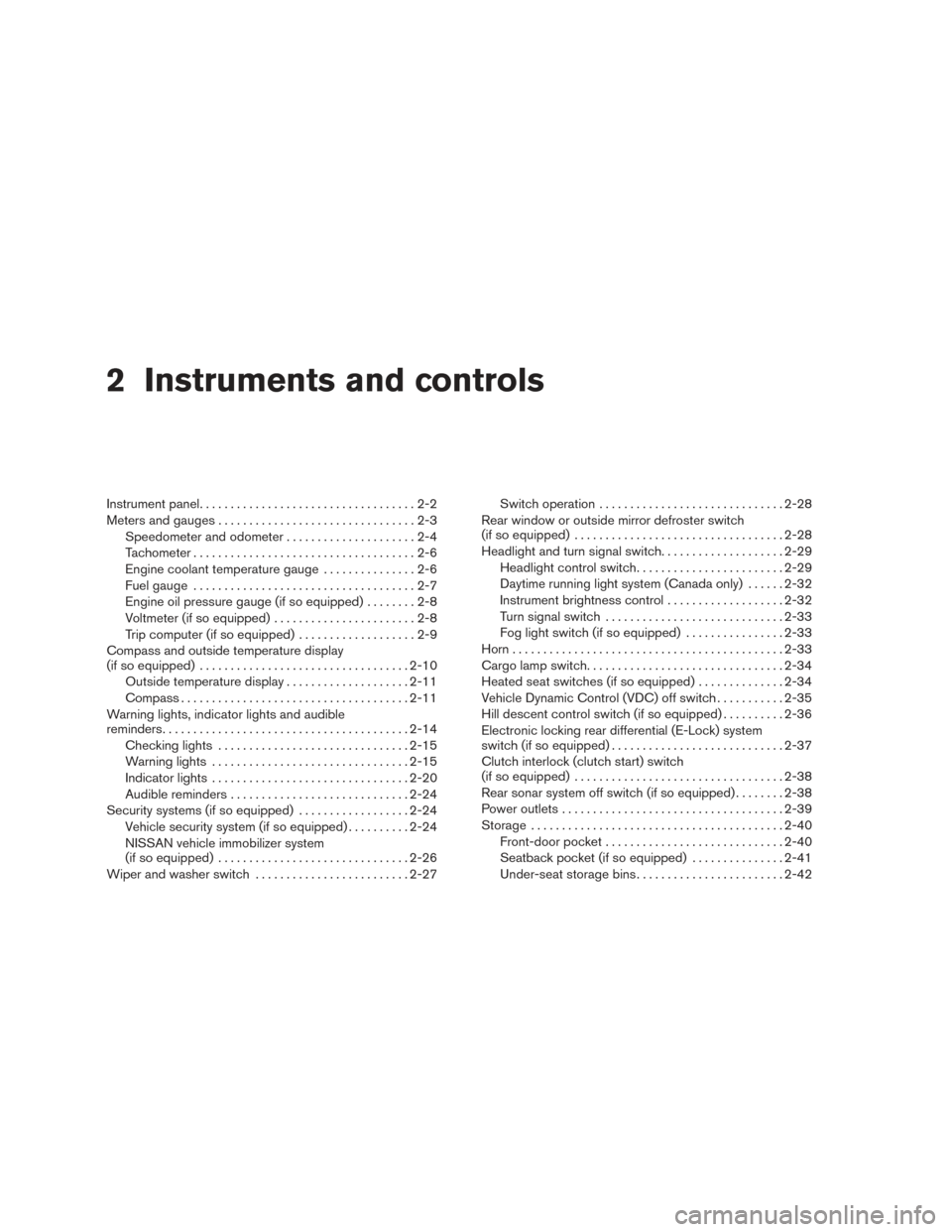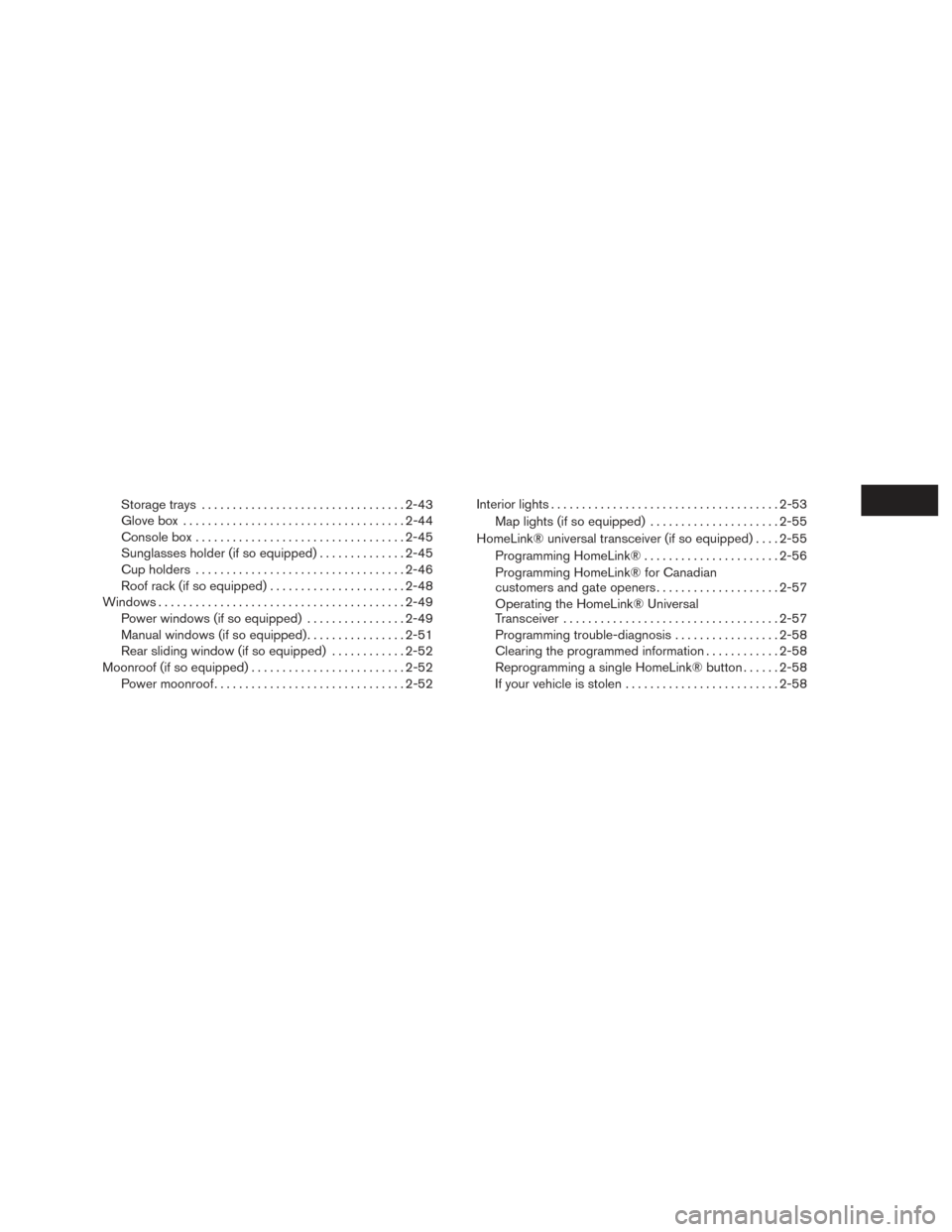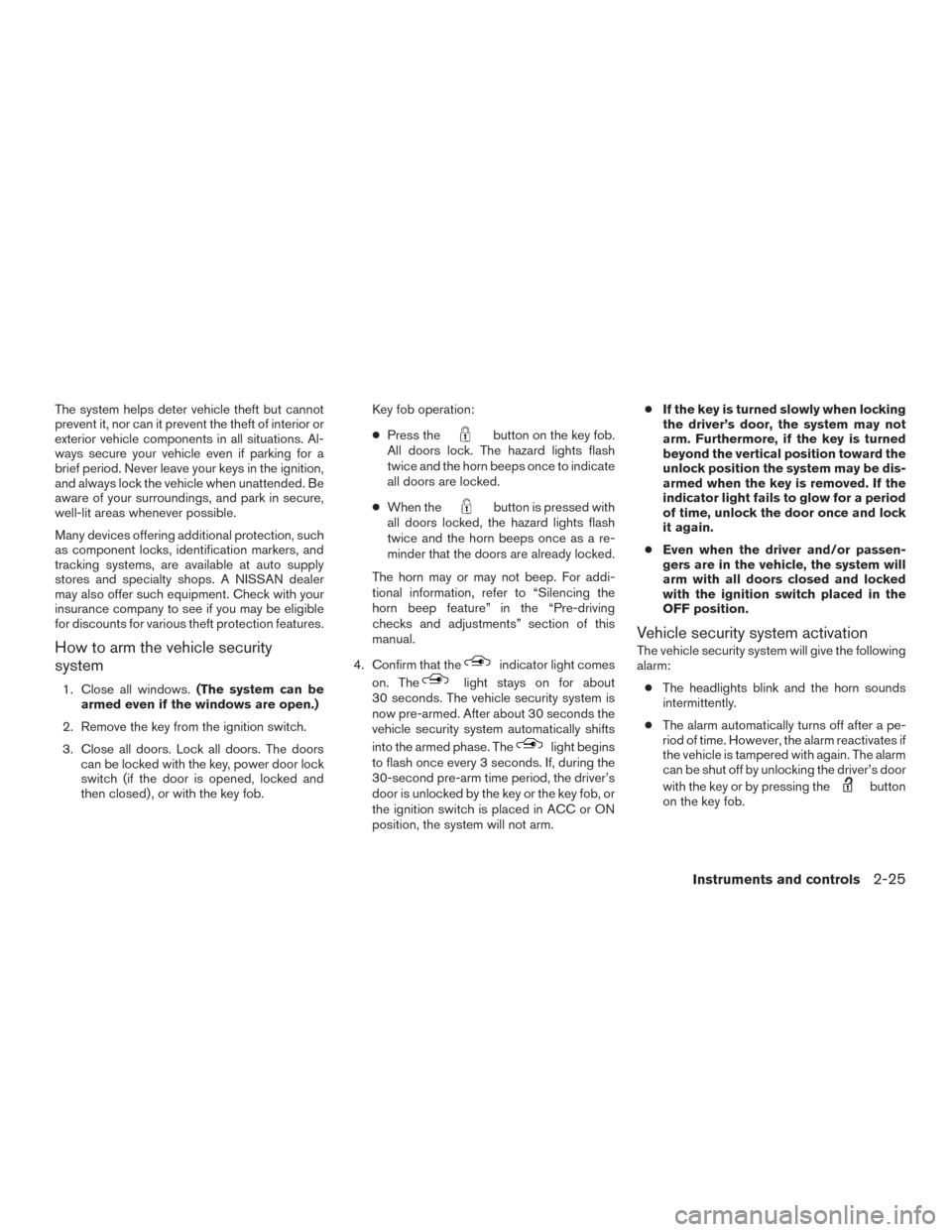Page 12 of 478
1. Engine hood (P. 3-10)
2. Wiper and washer switch (P. 2-27)
3. Windshield (P. 8-19)
4. Windows (P. 2-49)
5. Door locks (P. 3-3)Key fob (if so equipped) (P. 3-6)
Keys (P. 3-2)
6. Mirrors (P. 3-15)
7. Tire pressure (P. 8-30) Flat tire (P. 6-3)
Tire chains (P. 8-30)
8. Headlight and turn signal switch
(P. 2-29)
Daytime running lights system
(if so equipped) (P. 2-29)
Replacing bulbs (P. 8-26)
9. Fog light switch (if so equipped)
(P. 2-29)
Refer to the page number indicated in pa-
rentheses for operating details.
LII2481
EXTERIOR FRONT
Illustrated table of contents0-3
Page 13 of 478
1. Rear sliding window (if so equipped)(P. 2-49)
2. Vehicle loading (P. 10-17) Tailgate (P. 3-18)
Truck box (P. 3-18)
Rearview camera (if so equipped)
(P. 4-10)
3. Rear sonar sensors (if so equipped)
(P. 5-41)
4. Replacing bulbs (P. 8-26)
5. Fuel-filler cap (P. 3-11) Fuel recommendation (P. 10-2)
Refer to the page number indicated in pa-
rentheses for operating details.
LII2482
EXTERIOR REAR
0-4Illustrated table of contents
Page 53 of 478
1. Top tether strap
2. Anchor point
Top tether anchor point locations
Anchor points are located in the following loca-
tions:● On the back of the front passenger seat
(King Cab only) as shown. ●
Under the rear window behind the rear
bench seat (Crew Cab models only) as
shown.
1. Cover plate
2. Routing bracket
3. Anchor point
●On the floor between the jump seat belt
buckles in the center of the vehicle (King
Cab only) as shown.
The anchor point is located on the floor between
the jump seat belt buckles in the center of the
vehicle. The routing bracket is located behind the
cover plate under the rear window above the
jump seat.
Front passenger seat
(King Cab models only)
LRS0572
Rear bench seat (Crew Cab models only)
LRS0393
Jump seats
(King Cab models - passenger side shown)
LRS2101
1-32Safety—Seats, seat belts and supplemental restraint system
Page 94 of 478
WARNING
●Never let children ride unrestrained or
extend their hands or face out of the
window. Do not attempt to hold them in
your lap or arms. Some examples of
dangerous riding positions are shown
in the illustrations.
ARS1133ARS1041
Safety—Seats, seat belts and supplemental restraint system1-73
Page 97 of 478
WARNING
●The seat belts, the side air bags and
curtain air bags are most effective when
you are sitting well back and upright in
the seat. The side air bag and curtain air
bag inflate with great force. Do not al-
low anyone to place their hand, leg or
face near the side air bag on the side of
the seatback of the front seat or near
the side roof rails. Do not allow anyone
sitting in the front seats or rear out-
board seats to extend their hand out of
the window or lean against the door.
Some examples of dangerous riding
positions are shown in the previous
illustrations.
Do not lean against doors or windows.
LRS0396
Do not lean against doors or windows.
SSS0162
1-76Safety—Seats, seat belts and supplemental restraint system
Page 109 of 478

2 Instruments and controls
Instrument panel...................................2-2
Meters and gauges ................................2-3
Speedometer and odometer .....................2-4
Tachometer ....................................2-6
Engine coolant temperature gauge ...............2-6
Fuel gauge ....................................2-7
Engine oil pressure gauge (if so equipped) ........2-8
Voltmeter (if so equipped) .......................2-8
Trip computer (if so equipped) ...................2-9
Compass and outside temperature display
(if so equipped) .................................. 2-10
Outside temperature display ....................2-11
Compass ..................................... 2-11
Warning lights, indicator lights and audible
reminders ........................................ 2-14
Checking lights ............................... 2-15
Warning lights ................................ 2-15
Indicator lights ................................ 2-20
Audible reminders ............................. 2-24
Security systems (if so equipped) ..................2-24
Vehicle security system (if so equipped) ..........2-24
NISSAN vehicle immobilizer system
(if so equipped) ............................... 2-26
Wiper and washer switch ......................... 2-27Switch operation
.............................. 2-28
Rear window or outside mirror defroster switch
(if so equipped) .................................. 2-28
Headlight and turn signal switch ....................2-29
Headlight control switch ........................ 2-29
Daytime running light system (Canada only) ......2-32
Instrument brightness control ...................2-32
Turn signal switch ............................. 2-33
Fog light switch (if so equipped) ................2-33
Horn ............................................ 2-33
Cargo lamp switch................................ 2-34
Heated seat switches (if so equipped) ..............2-34
Vehicle Dynamic Control (VDC) off switch ...........2-35
Hill descent control switch (if so equipped) ..........2-36
Electronic locking rear differential (E-Lock) system
switch (if so equipped) ............................ 2-37
Clutch interlock (clutch start) switch
(if so
equipped) .................................. 2-38
Rear sonar system off switch (if so equipped) ........2-38
Power outlets .................................... 2-39
Storage ......................................... 2-40
Front-door pocket ............................. 2-40
Seatback pocket (if so equipped) . . .............2-41
Under-seat storage bins ........................ 2-42
Page 110 of 478

Storage trays................................. 2-43
Glove box .................................... 2-44
Console box .................................. 2-45
Sunglasses holder (if so equipped) ..............2-45
Cup holders .................................. 2-46
Roof rack (if so equipped) ......................2-48
Windows ........................................ 2-49
Power windows (if so equipped) ................2-49
Manual windows (if so equipped) ................2-51
Rear sliding window (if so equipped) ............2-52
Moonroof (if so equipped) ......................... 2-52
Power moonroof ............................... 2-52Interior lights
..................................... 2-53
Map lights (if so equipped) .....................2-55
HomeLink® universal transceiver (if so equipped) ....2-55
Programming HomeLink® ......................2-56
Programming HomeLink® for Canadian
customers and gate openers ....................2-57
Operating the HomeLink® Universal
Transceiver ................................... 2-57
Programming trouble-diagnosis .................2-58
Clearing the programmed information ............2-58
Reprogramming a single HomeLink® button ......2-58
If your vehicle is stolen ......................... 2-58
Page 134 of 478

The system helps deter vehicle theft but cannot
prevent it, nor can it prevent the theft of interior or
exterior vehicle components in all situations. Al-
ways secure your vehicle even if parking for a
brief period. Never leave your keys in the ignition,
and always lock the vehicle when unattended. Be
aware of your surroundings, and park in secure,
well-lit areas whenever possible.
Many devices offering additional protection, such
as component locks, identification markers, and
tracking systems, are available at auto supply
stores and specialty shops. A NISSAN dealer
may also offer such equipment. Check with your
insurance company to see if you may be eligible
for discounts for various theft protection features.
How to arm the vehicle security
system
1. Close all windows.(The system can be
armed even if the windows are open.)
2. Remove the key from the ignition switch.
3. Close all doors. Lock all doors. The doors can be locked with the key, power door lock
switch (if the door is opened, locked and
then closed) , or with the key fob. Key fob operation:
●
Press the
button on the key fob.
All doors lock. The hazard lights flash
twice and the horn beeps once to indicate
all doors are locked.
● When the
button is pressed with
all doors locked, the hazard lights flash
twice and the horn beeps once as a re-
minder that the doors are already locked.
The horn may or may not beep. For addi-
tional information, refer to “Silencing the
horn beep feature” in the “Pre-driving
checks and adjustments” section of this
manual.
4. Confirm that the
indicator light comes
on. The
light stays on for about
30 seconds. The vehicle security system is
now pre-armed. After about 30 seconds the
vehicle security system automatically shifts
into the armed phase. The
light begins
to flash once every 3 seconds. If, during the
30-second pre-arm time period, the driver’s
door is unlocked by the key or the key fob, or
the ignition switch is placed in ACC or ON
position, the system will not arm. ●
If the key is turned slowly when locking
the driver’s door, the system may not
arm. Furthermore, if the key is turned
beyond the vertical position toward the
unlock position the system may be dis-
armed when the key is removed. If the
indicator light fails to glow for a period
of time, unlock the door once and lock
it again.
● Even when the driver and/or passen-
gers are in the vehicle, the system will
arm with all doors closed and locked
with the ignition switch placed in the
OFF position.
Vehicle security system activation
The vehicle security system will give the following
alarm:
● The headlights blink and the horn sounds
intermittently.
● The alarm automatically turns off after a pe-
riod of time. However, the alarm reactivates if
the vehicle is tampered with again. The alarm
can be shut off by unlocking the driver’s door
with the key or by pressing the
button
on the key fob.
Instruments and controls2-25